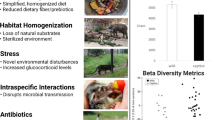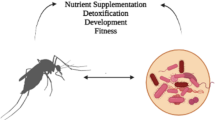Abstract
Animals develop microbial associations (i.e., their microbiome) early in life that have been linked to changes in host development, physiology, and survival. However, microbial sources contributing to initial microbial colonization remain unclear, particularly in oviparous animals. We described a potential microbial source, the eggshell microbiome of Western Bluebirds (Sialia mexicana), a cavity nesting bird. We found bacteria commonly seen in the microbiomes of other birds; thus, eggshells could represent a source during initial microbial colonization. Eggshell microbiomes also represented an independent group from the gut microbiomes of similar species. Future work should explore the relative contribution of eggshells to initial microbial colonization of nestlings.
Zusamemnfassung
Das Mikrobiom der Eischale als potenzielles mikrobielles Reservoir bei einem Höhlenbrüter
Tiere entwickeln früh im Leben mikrobielle Lebensgemeinschaften (d. h. ihr Mikrobiom), die mit Veränderungen in der Entwicklung, der Physiologie und dem Überleben des Wirts in Verbindung gebracht werden. Die Mikroben-Quellen, die zur mikrobiellen Erstbesiedlung eines Tieres beitragen, sind jedoch nach wie vor unklar, insbesondere bei eierlegenden Tieren. Wir beschreiben eine potenzielle mikrobielle Quelle, nämlich das Mikrobiom der Eischalen des Blaukehl-Hüttensängers (Sialia mexicana), eines Höhlenbrüters. Wir fanden Bakterien, die auch in den Mikrobiomen anderer Vögel vorkommen; somit könnten die Eischalen eine Quelle der mikrobiellen Erstbesiedlung darstellen. Die Mikrobiome der Eischalen zeigten eine vom Darmmikrobiom ähnlicher Vogelarten unabhängige Zusammenstellung von Bakterien. Künftige Untersuchungen sollten sich den Anteil der Eischalen bei der mikrobiellen Erstbesiedlung von Nestlingen vornehmen.


Similar content being viewed by others
Data availability
Raw 16S rRNA data are publicly available at the SRA of NCBI under BioProject # PRJNA860643.
References
Callahan BJ, McMurdie PJ, Rosen MJ et al (2016) DADA2: high-resolution sample inference from Illumina amplicon data. Nat Methods 13:581–583. https://doi.org/10.1038/nmeth.3869
Campos-Cerda F, Bohannan BJM (2020) The nidobiome: a framework for understanding microbiome assembly in neonates. Trends Ecol Evol 35:573–582. https://doi.org/10.1016/j.tree.2020.03.007
Cordaux R, Paces-Fessy M, Raimond M et al (2007) Molecular characterization and evolution of arthropod-pathogenic Rickettsiella bacteria. Appl Environ Microbiol 73:5045–5047. https://doi.org/10.1128/AEM.00378-07
Cuatianquiz-Lima C, Macías Garcia C (2016) Pre- and post-experimental manipulation assessments confirm the increase in number of birds due to the addition of nest boxes. PeerJ 2016:1–17. https://doi.org/10.7717/peerj.1806
D’Alba L, Shawkey MD (2015) Mechanisms of antimicrobial defense in avian eggs. J Ornithol 156:399–408. https://doi.org/10.1007/s10336-015-1226-1
Gerbáčová K, Maliničová L, Kisková J et al (2020) The faecal microbiome of building-dwelling insectivorous bats (Myotis myotis and Rhinolophus hipposideros) also contains antibiotic-resistant bacterial representatives. Curr Microbiol 77:2333–2344. https://doi.org/10.1007/s00284-020-02095-z
Grizard S, Versteegh MA, Ndithia HK et al (2015) Shifts in bacterial communities of eggshells and antimicrobial activities in eggs during incubation in a ground-nesting passerine. PLoS ONE 10:1–20. https://doi.org/10.1371/journal.pone.0121716
Guinan JA, Gowaty PA, Eltzroth EK (2020) Western bluebird (Sialia mexicana). In: Poole AF (ed) Birds of the world. Cornell Lab of Ornithology, Ithaca
Ingala MR, Albert L, Addesso A et al (2021) Differential effects of elevated nest temperature and parasitism on the gut microbiota of wild avian hosts. Animal Microbiome 3:1–11. https://doi.org/10.1186/s42523-021-00130-3
Klindworth A, Pruesse E, Schweer T et al (2013) Evaluation of general 16S ribosomal RNA gene PCR primers for classical and next-generation sequencing-based diversity studies. Nucleic Acids Res 41:1–11. https://doi.org/10.1093/nar/gks808
Kreisinger J, Čízková D, Kropácková L, Albrecht T (2015) Cloacal microbiome structure in a long-distance migratory bird assessed using deep 16sRNA pyrosequencing. PLoS ONE 10:1–14. https://doi.org/10.1371/journal.pone.0137401
Martínez-García Á, Soler JJ, Rodríguez-Ruano SM et al (2015) Preening as a vehicle for key bacteria in Hoopoes. Microb Ecol 70:1024–1033. https://doi.org/10.1007/s00248-015-0636-1
McFall-Ngai M, Hadfield MG, Bosch TCG et al (2013) Animals in a bacterial world, a new imperative for the life sciences. Proc Natl Acad Sci 110:3229–3236. https://doi.org/10.1073/pnas.1218525110
McMurdie PJ, Holmes S (2013) Phyloseq: an R package for reproducible interactive analysis and graphics of microbiome census data. PLoS ONE. https://doi.org/10.1371/journal.pone.0061217
Milani C, Duranti S, Bottacini F et al (2017) The first microbial colonizers of the human gut: composition, activities, and health implications of the infant gut microbiota. Microbiol Mol Biol Rev 81:1–67. https://doi.org/10.1128/MMBR.00036-17
Müller HE (1986) Isolation of Serratia fonticola from birds. Zentralblatt Fur Bakteriologie Mikrobiologie Und Hygiene - Abt 1 Orig A 261:212–218. https://doi.org/10.1016/S0176-6724(86)80038-4
Nyholm SV (2020) In the beginning: egg-microbe interactions and consequences for animal hosts: egg microbiomes in animals. Philos Trans R Soc B Biol Sci. https://doi.org/10.1098/rstb.2019.0593rstb20190593
Poelen JH, Simons JD, Mungall CJ (2014) Global biotic interactions: an open infrastructure to share and analyze species-interaction datasets. Eco Inform 24:148–159. https://doi.org/10.1016/j.ecoinf.2014.08.005
Porras-Reyes B, Ancona S, Ríos-Chelén AA et al (2021) Sex bias in parental care is associated with brood age and fledglings’ growth rate in Western Bluebirds Sialia mexicana. J Ornithol 162:409–419. https://doi.org/10.1007/s10336-020-01836-y
Quast C, Pruesse E, Yilmaz P et al (2013) The SILVA ribosomal RNA gene database project: improved data processing and web-based tools. Nucleic Acids Res 41:590–596. https://doi.org/10.1093/nar/gks1219
Sharma P, Killmaster LF, Volkening JD et al (2018) Draft genome sequences of five novel Ochrobactrum spp. isolated from different avian hosts in Nigeria. Genome Announc 6:14–16. https://doi.org/10.1128/genomeA.00063-18
Sprockett D, Fukami T, Relman DA (2018) Role of priority effects in the early-life assembly of the gut microbiota. Nat Rev Gastroenterol Hepatol 15:197–205. https://doi.org/10.1038/nrgastro.2017.173
Teyssier A, Lens L, Matthysen E, White J (2018) Dynamics of gut microbiota diversity during the early development of an avian host: evidence from a cross-foster experiment. Front Microbiol 9:1–12. https://doi.org/10.3389/fmicb.2018.01524
Trevelline BK, MacLeod KJ, Knutie SA et al (2018) In ovo microbial communities: a potential mechanism for the initial acquisition of gut microbiota among oviparous birds and lizards. Biol Let 14:3–6. https://doi.org/10.1098/rsbl.2018.0225
van Veelen HPJ, Falcao Salles J, Tieleman BI (2017) Multi-level comparisons of cloacal, skin, feather and nest-associated microbiota suggest considerable influence of horizontal acquisition on the microbiota assembly of sympatric Woodlarks and Skylarks. Microbiome 5:156. https://doi.org/10.1186/s40168-017-0371-6
van Veelen HPJ, Falcão Salles J, Tieleman BI (2018) Microbiome assembly of avian eggshells and their potential as transgenerational carriers of maternal microbiota. ISME J 12:1375–1388. https://doi.org/10.1038/s41396-018-0067-3
Wiebe KL (2001) Microclimate of tree cavity nests: Is it important for reproductive success in northern flickers? Auk 118:412–421. https://doi.org/10.2307/4089802
Acknowledgements
This work was supported by Consejo Nacional de Ciencia y Tecnología (CONACyT 220418 and INFR-2015-01-253217) and PRODEP (UATLX-PTC-129) grants to BM. Financial support for FCC was provided by Grant 490792 CONACYT-Ciencia de Frontera 2020.
Author information
Authors and Affiliations
Contributions
Study design by BM and YNN. Field samples were taken by BM, LN and CCL. Bench work was performed by LN and YNN. Data analysis and manuscript preparation was performed by FCC. BM, RT and YNN contributed to discussion of results. Comments and approval of final version by all authors. The authors have no conflicts of interest to declare.
Corresponding authors
Additional information
Communicated by I. Moore.
Publisher's Note
Springer Nature remains neutral with regard to jurisdictional claims in published maps and institutional affiliations.
Supplementary Information
Below is the link to the electronic supplementary material.
Rights and permissions
Springer Nature or its licensor (e.g. a society or other partner) holds exclusive rights to this article under a publishing agreement with the author(s) or other rightsholder(s); author self-archiving of the accepted manuscript version of this article is solely governed by the terms of such publishing agreement and applicable law.
About this article
Cite this article
Campos-Cerda, F., Torres, R., Nava, L. et al. Eggshell microbiome as a potential microbial reservoir in a cavity nesting bird. J Ornithol 164, 217–222 (2023). https://doi.org/10.1007/s10336-022-02028-6
Received:
Revised:
Accepted:
Published:
Issue Date:
DOI: https://doi.org/10.1007/s10336-022-02028-6




